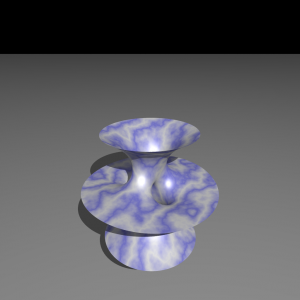Posts in the year 2013
Costa's minimal surface with PovRay
- 30 December 2013
- Software
A student of mine worked on a project to produce beautiful pictures of Costa's minimal surface with the PovRay ray tracer. For this purpose she needed to triangulate the and compute normals to it at the vertices. It is not too hard to do the latter part, and the Internet offers several ways of doing it, but the normals are a bit tricky. If anyone can calculate them with paper and pencil I'd like to hear about it.
I went back to my undergraduate days when I actually did differential geometry and churned out the normals with Mathematica. It took a bit of work, kind advice from my colleague Pavle Saksida, and a pinch of black magic (to extract the Delaunay triangulation from Mathematica), so I thought I might as well publish the result at my GitHub costa-surface repository. The code is released into public domain. Have fun making pictures of Costa's surface! Here is mine (deliberately non-fancy):
→ continue readingThe elements of an inductive type
- 28 August 2013
- Constructive math, Type theory, Tutorial
In the HoTT book issue 460 a question by gluttonousGrandma (where do people get these nicknames?) once more exposed a common misunderstanding that we tried to explain in section 5.8 of the book (many thanks to Bas Spitters for putting the book into Google Books so now we can link to particular pages). Apparently the following belief is widely spread, and I admit to holding it a couple of years ago:
An inductive type contains exactly those elements that we obtain by repeatedly using the constructors.
If you believe the above statement you should keep reading. I am going to convince you that the statement is unfounded, or that at the very least it is preventing you from understanding type theory.
→ continue reading (29 comments)How to review formalized mathematics
- 19 August 2013
- General
Recently I reviewed a paper in which most proofs were done in a proof assistant. Yes, the machine guaranteed that the proofs were correct, but I still had to make sure that the authors correctly formulated their definitions and theorems, that the code did not contain hidden assumptions, that there were no unfinished proofs, and so on.
In a typical situation an author submits a paper accompanied with some source code which contains the formalized parts of the work. Sometimes the code is enclosed with the paper, and sometimes it is available for download somewhere. It is easy to ignore the code! The journal finds it difficult to archive the code, the editor naturally focuses on the paper itself, the reviewer trusts the authors and the proof assistant, and the authors are tempted not to mention dirty little secrets about their code. If the proponents of formalized mathematics want to avert a disaster that could destroy their efforts in a single blow, they must adopt a set of rules that will ensure high standards. There is much more to trusting a piece of formalized mathematics than just running it through a proof checker.
→ continue reading (17 comments)The HoTT book
- 20 June 2013
- Constructive math, General, Type theory, News, Publications
The HoTT book is finished!
Since spring, and even before that, I have participated in a great collaborative effort on writing a book on Homotopy Type Theory. It is finally finished and ready for public consumption. You can get the book freely at http://homotopytypetheory.org/book/. Mike Shulman has written about the contents of the book, so I am not going to repeat that here. Instead, I would like to comment on the socio-technological aspects of making the book, and in particular about what we learned from open-source community about collaborative research.
→ continue reading (10 comments)